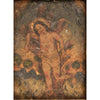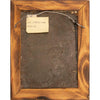See more: Antique Retablos
Saint Sebastian / San Sebastián Mártir 19th Century Mexican Retablo
$ 2,400.00
- Saint San Sebastián Mártir 19th Century Mexican Retablo
- Mexican Retablo, depicting Saint San Sebastián Mártir (St. Sebastian, Martyr),
- Oil paint on tin, framed, circa 19th century
- Measurements: image: 6.5 x 4.5", frame: 9 x 7" with Frame
- One of the "Holy Grails of 19th Century Mexican Retablos"; an authentic Saint Sebastian in very good condition.
- Sebastian (Latin: Sebastianus; c. AD 255 – c. AD 288) was an early Christian Saint and Martyr.
- According to traditional belief, he was killed during the Diocletianic Persecution of Christians. He was initially tied to a post or tree and shot with arrows, though this did not kill him. He was, according to tradition, rescued and healed by Irene of Rome, which became a popular subject in 17th-century painting.
- In all versions of the story, shortly after his recovery he went to Diocletian to warn him about his sins, and as a result was clubbed to death.
- He is venerated in the Catholic Church and the Orthodox Church.
The oldest record of the details of Sebastian's martyrdom is found in the Chronograph of 354, which mentions him as a Martyr, venerated on January 20. He is also mentioned in a sermon on Psalm 118 by 4th-century bishop Ambrose of Milan: in his sermon, Ambrose stated that Sebastian came from Milan and that he was already venerated there at that time. The full account of his Martyrdom comes from the Passio Sancti Sebastiani, a 5th-century text written by an anonymous author, possibly Arnobius the Younger. - Sebastian is a popular Male Saint, especially today among Athletes.
- In Roman Catholicism, Sebastian is the Patron Saint of Athletes as well as the Patron Saint of Archers. He is commonly depicted in art and literature tied to a post or tree and shot with arrows.
- In medieval times, he was regarded as a Saint with a special ability to Intercede to Protect from Plague, and Devotion to him greatly increased when Plague was active.
- Origin is Mexico




